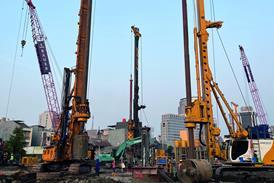With the timing and manner of the UK鈥檚 exit from the EU in doubt once more, Simon Rawlinson of Arcadis looks at the options available to clients and their supply chains to manage the consequences of a disruptive Brexit
01 / Introduction
Whether readers think Brexit is a good idea or not, they can hardly deny that construction businesses are likely to be disrupted as a result of the UK leaving the EU. Whether this happens in the aftermath of a no-deal exit or over an extended transition period, there will be big changes to the way in which the industry accesses some of its labour and materials. We can also potentially expect longer-term consequences for the range of products available in the UK, if our standards start to diverge from those adopted in Europe.
Whereas the UK鈥檚 highly capitalised car manufacturing sector has spent more than 拢330m on Brexit preparations, the evidence is that construction firms have been able to do very little to prepare other than in formulating project-level contingency plans.
The fragmentation of the sector, its discontinuity of workload and its low profitability mean make it difficult for the construction industry to adopt a common approach to mitigation or to find the resources to fund it.
A recent supply chain survey undertaken by a tier-one contractor highlighted that while nearly 65% of companies relied on imported materials, only two-thirds of these firms have actually made stockpiling plans. Estimates of the effect of a disruptive no-deal exit are hard to come by. As there are no official forecasts for effects on GDP, it is particularly difficult to assess the consequences for construction workload or future market conditions. Similarly, it is hard to foresee what might happen on individual projects when the supply of labour and materials is organised in such a piecemeal fashion.
What is pretty clear, however, is that the risks of such disruption have been passed down the supply chain through the use of existing, conventional contract provisions.
The evidence is that Brexit clauses have been used very little in construction. Existing provisions give very little opportunity for relief. They also lock contractors and their supply chain into significant cost and time commitments that may prove difficult to meet in the event of a disruptive Brexit. One national contractor with a turnover of more than 拢1bn has estimated that, if all its contracts were to be delayed by Brexit disruption, then the cost associated with reduced turnover and delay damages could be equivalent to 5%-10% of turnover. Given that average profitability of tier-one contractors is 1.5% of turnover, the potential for significant financial damage is clear.
While it is unlikely all projects would be disrupted, delays could be triggered by a single package on a critical path of a project. The eventual effects could be widespread 鈥� particularly in London and the South-east, where reliance on European labour is higher. However, the current European workforce won鈥檛 disappear overnight, despite the best efforts of the Home Office to end freedom of movement on 31 October in the event of no-deal.
While the immediate focus of Brexit planning has to be on short-term mitigation, it is vital not to overlook the wider transformational opportunity that the changes might introduce.
Whether through innovation to improve productivity by reducing dependence on on-site labour or new opportunities for UK-based product manufacturers, it is also important that clients and industry seek to create some positive momentum from what is likely to be major, long-lasting change.

02 / Unpicking the Brexit challenge
After three-and-a-half years of steady commentary on the pros and cons of the UK鈥檚 exit from the EU, it is reasonable to expect that the full implications of the changes will be understood and prepared for, if not actually acted on. Construction businesses are exposed to risk in three main areas: labour, materials and currency fluctuation. However, these combine with other factors, set out below, which will may either mitigate or magnify the impacts.
Labour
The labour challenge is in many ways the easiest to describe but it is the one for which its impact is hardest to forecast 鈥� not only because it is difficult to tell how much of the current EU labour force will remain, and also because proposals for a new migrant labour scheme are up in the air following the recent government decision to start a review of Australia-style points-based systems. EU workers in construction account for 10%-12% of the UK鈥檚 2.4 million-strong labour force. There are many more working in the associated professions. Previously published Arcadis research highlighted that the normal rate of attrition for EU workers returning home after a spell in the UK is around 20,000-30,000 a year. Should this attrition rate accelerate under a no-deal scenario, particularly if new migrants found it harder to enter the UK, then the EU workforce could deplete at an accelerating rate.
At present there is no clarity on whether the currently proposed post-Brexit migration model will be adopted unamended. As proposed, it is unhelpful to construction in that eligible employees need to have the equivalent of A levels, earn at least 拢30,000 a year and be directly employed. Ironically, Brexit may accelerate the take-up of direct employment as a means of securing talent from overseas.
Materials
The materials challenge is particularly focused on just-in-time logistics and disruption to ports. A number of clients and their suppliers will have needlessly invested in warehouse space and consolidation centres in preparation for the March deadline and may be less willing or able to do so ahead of whatever date is finally adopted for the UK鈥檚 departure.
While the focus of debate is often on high-profile products such as curtain wall delivered on a just-in time basis, the biggest impacts could be felt in other sectors, particularly M&E, where products such as wiring, light fittings and air-conditioning units criss-cross the channel as part of a complex, integrated construction supply chain. UK product manufacturers are also dependent on imported components, but not all of these can be stockpiled.
Currency fluctuations
The impact of currency changes on the cost of materials is also well known, and this is likely to be the most immediate consequence of a poorly managed Brexit. Commonly used devaluation scenarios suggest that there could be a further 10% reduction in the value of sterling as a result of a disruptive exit.
Other issues
Other issues and risks that clients and suppliers need to take into account in the immediate proximity to Brexit will include:
- Management of client and personnel data across borders as a third country in accordance with GDPR
- Continuity of workload as clients and investors reappraise UK markets and as the public sector delays decision-making as a result of the focus of resources on the short-term priorities of Operation Yellowhammer
- Ability of contractors and subcontractors to fully allow for increased programme and cost risk in a softening and competitive tender market
- Impact of Brexit-related cost and time penalties on the ability of the supply chain to trade
- Risk to availability of finance from overseas investors and banks.
At present, there are few obvious upside opportunities associated with Brexit-driven change. These are likely to emerge as the domestic manufacturing and logistics industries invest to serve reshaped markets. One opportunity could be the economic stimulus package that government has promised to deliver as part of its wider post-European strategy. This is almost certain to involve incentivising capital investment 鈥� potentially driving additional demand for construction. Should this stimulus crystallise, finding the capacity to respond will be a nice problem to have.
03 / How ready is the supply chain?
Despite having had plenty of time, business preparation for Brexit has been slow. A good example is the customs registration that UK businesses will need if they plan to export to the EU after Brexit. In August, only 25% of the 245,000 UK businesses that export to the EU had registered 鈥� prompting the UK government to issue registration numbers to all UK VAT-registered businesses, whether they export or not. Further evidence of preparations comes from settled status data. So far, only 1 million out of 3.6 million EU citizens entitled to UK settled status have begun the process. Unfortunately for construction, there are no equivalent data sources to assess sector readiness, and many of the sector鈥檚 200,000-plus businesses seem to have put Brexit preparations in the 鈥渢oo difficult鈥� box. Unfortunately, while many of the problems that Brexit poses are complex and time-consuming, the obligations set out in most unamended contracts are equally intractable.
Survey data 鈥� at least from the supply chain for larger contractors 鈥� provides a more positive picture. Over 80% of one main contractor鈥檚 supply chain in a recent survey confirmed they had reviewed goods and labour in the past six months. Furthermore, 75% had discussed liabilities and mitigations with their suppliers. Whether action has been taken is more difficult to assess. Individual specialist contractors are taking steps to de-risk their business by reducing the amount of labour needed on site or by purchasing materials in advance. However, these initiatives are being undertaken on a contractor-by-contractor basis, and with projects only being as secure as their weakest link, more assurance is required.
Given how fragmented the construction supply chain is, and the extent to which many subcontractors rely on both a network of small suppliers and self-employed labour, it is difficult to judge the practical level of readiness in terms of fully worked-up contingency plans. This highlights why it is increasingly necessary for clients to take the initiative in assessing the readiness of the supply chain and the thoroughness of mitigation planning. A five-point framework for such an assessment is set out in the table in section five, opposite.

04 / Planning for no-deal mitigations
With a no-deal Brexit potentially six weeks away, there is still time to implement a short-term mitigation plan for projects on site and to build in contingencies for those in the design and procurement stages. As so often, the business challenges a no-deal exit is likely to trigger are best faced collectively, supported by a transparent overview of risk ownership and exposure.
In reality it is likely these conversations are not taking place. Instead, most Brexit-risk exposure is being handled using industry-standard amendments to widely used contracts, offering very little relief to the supply chain. It is widely considered, for example, that force majeure clauses will not apply 鈥� and anyway a successful claimant would need to show it had taken every step to mitigate the loss. Similarly, determination clauses give little opportunity for contractors or subcontractors to step away from liabilities. This means mitigation steps within the contract could be vital.
Short-term planning
Short-term mitigation planning for projects currently on site could potentially cover the following areas:
- Better understanding of project status, with greater focus on certainty of programme and financial health of the supply chain to provide assurance that completion dates can be met. This is particularly important on projects that are already subject to some delay or change in scope and which cannot rely on the baseline of the contract.
- Contingency planning 鈥� putting in place plans for the effective management of disruption. Many construction businesses are quite comfortable operating in reactive mode, but having a plan for obvious eventualities such as the lack of availability of resources or disruption to traffic should result in better outcomes.
- Detailed programming 鈥� project teams should identify programme constraints that might prevent early purchase of materials. Early completion of design work ahead of contracted information release dates is an example of how the project team can support the supply chain with their procurement programme.
- Payment for offsite materials 鈥� clients and their advisers can proactively use valuation procedures backed by surety bonds to support the early securing of resources.
- Instructing as changes any acts of forbearance agreed by the client and supply chain, no matter how small.
Long-term planning
In the longer term, a wider range of options are available to project teams to de-risk projects for Brexit. These are best considered as part of a wider risk-management strategy. Examples of such long-term strategies include:
- Design and specification changes to mitigate disruption 鈥� such as sourcing products and systems from within the UK in order to avoid disruption at borders.
- Programme allowances 鈥� incorporating client-controlled programme float to allow for potential logistical delays.
- Change of law clauses 鈥� for longer-term contracts only, incorporating the ability to renegotiate an agreement in response to changes with an unforeseeable impact.
- Realignment of planned workload to supply chain capacity 鈥� applying mainly for frameworks and alliances, the rescheduling and potential reallocation of a programme of work to take into account reduced supply chain capacity.
- Reconfiguring supply chains 鈥� either to reduce dependence on imported goods or to focus on businesses with a more robust balance sheet.
- Reduction in the use of labour 鈥� adopting, for example, solutions that require lower skill levels on site or that reduce the overall operative numbers required for on-site works, as well as increasing the proportion of work that is done offsite.
05 / The five-point Brexit readiness plan
Arcadis has drawn up a five-point plan of essential steps to increase transparency and readiness. In our experience, while many clients and project teams are only too aware of the potential implications of Brexit, they are often prepared to rely on conventional contract measures to deal with any fall-out should it occur.
Given the varying levels of preparedness and widespread potential for exposure to delay through the materials and labour supply chain, there is growing potential for a client or a contractor to develop a competitive advantage through greater transparency and increased readiness for any disruption that might follow the UK鈥檚 exit from the EU.
We have been using a five-step tool to support project teams in developing their proposals. The following outline sets out the key features of the plan.
| Actions | Details and examples | |
|---|---|---|
|
Step 1 |
Engage with the supply chain |
By understanding the exposure of the supply chain to risks associated with labour availability or customs barriers, a project team can build a full picture of the potential for Brexit fall-out. Having an assessment of preparations made so far will highlight how resilient a project will be in the face of disruption. Examples include:
|
|
Step 2 |
Review the procurement strategy |
This review concerns risk allocation and in particular checking whether all risks have been identified and whether the transfer is cost-effective and watertight. Issues that might be examined include:
|
|
Step 3 |
Check the contract |
In anticipation that disputes might arise as a result of the interpretation of contract clauses and Brexit events, it is a good idea for all parties at all levels of the supply chain to make sure that contracts are in place, that they are being administered correctly and that contract provisions 鈥� particularly amended clauses 鈥� are properly understood. Particular areas that will benefit from attention include:
|
|
Step 4 |
Review finances |
Given heightened levels of uncertainty, the financial health of project team members could suffer if projects or project payments are delayed. Due diligence on the financial health of the supply chain will be increasingly important 鈥� not only to identify mitigating steps, but to put in place contingency plans in the event of failure within the supply chain.
|
|
Step 5 |
Prepare contingencies |
Put in place practical plans for known unknowns such as constraints on labour and materials availability. Also consider a wider range of disruptions, such as the potential for logistics upheaval as highlighted by Operation Yellowhammer. Contingency planning might also include internal planning for negotiations including what room for manoeuvre a client or contractor might have in agreeing forbearance. Accelerating the momentum in modelling project scenarios will also help to increase the focus of project teams in advance of exit day. |
06 / Conclusion
Business is thoroughly fed up with the distraction and disruption that Brexit negotiations have brought since 2016. Unfortunately, recent developments have contributed to even greater uncertainty and potentially brought the UK closer to a no-deal exit.
Construction鈥檚 approach to Brexit so far has been to wait and see 鈥� relying on the operation of tried and tested contracts and project management methods to continue to work in the event of a disruptive outcome. While these tools will probably protect clients and main contractors from the immediate impacts by passing the risk down the chain, ultimately the levels of uncertainty associated with the quality, programme and cost of projects will rise 鈥� potentially to a point where clients and their funders feel their interests cannot be protected.
In an ideal world, a Brexit resolution will be found, and much of this proactive management of risk will turn out to have been unnecessary. However, even during a transition period, changes to established ways of working are likely to crop up. By planning for the worst, clients and their construction supply chains will be in a better position to deliver the best possible outcomes in an increasingly unpredictable world.




















No comments yet